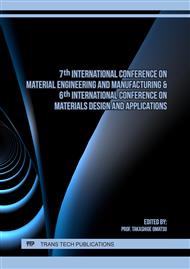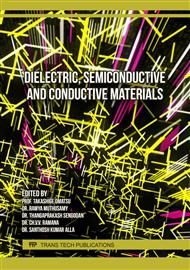p.119
p.129
p.139
p.145
p.157
p.163
p.175
p.181
p.189
Structural, Dielectric and Impedance Phenomena in Copper Ferrite Nano Powders for Hydroelectric Cell Application
Abstract:
Multiferroic materials have become the new era of research because it exhibits the presence of more than two ferroic orderings in its same phase. The pure copper ferrite nano powders have been prepared using sol-gel auto combustion method. The particle size is found to be near about 30-40 nm. Pure copper ferrite nanoparticles have been chosen to prepare because of its improved dielectric and structural properties. The sharpened peaks obtained from the XRD diffraction pattern confirms the crystalline nature of the sample. The structural and impedance studies of pure copper ferrites has also been reported. The SEM analysis confirms the formation of nanoparticles by revealing the value of grain size in nanometer range. The dielectric studies exhibit the Maxwell Wagner polarization and impedance spectroscopy confirms the contribution in conductivity from both grains and grain boundaries at room temperature. The fabrication of hydroelectric cell having area=0.75 cm2 has been done using pure copper ferrite nanoparticles which have shown improved value of current in wet state as compared to other ferrites like cobalt ferrites and bismuth ferrites. These all properties are responsible for improving the structural stability and thus this material can be suggested for fabricating the hydroelectric cells.
Info:
Periodical:
Pages:
157-162
Citation:
Online since:
October 2023
Authors:
Keywords:
Price:
Сopyright:
© 2023 Trans Tech Publications Ltd. All Rights Reserved
Share:
Citation:



